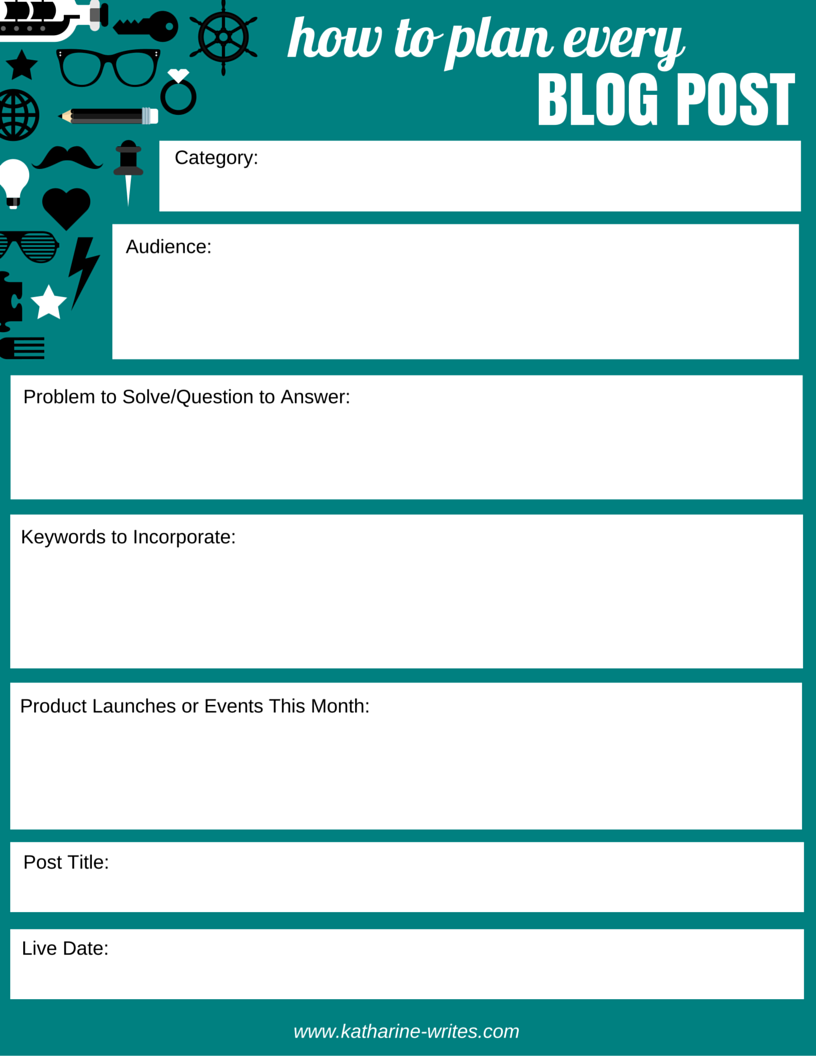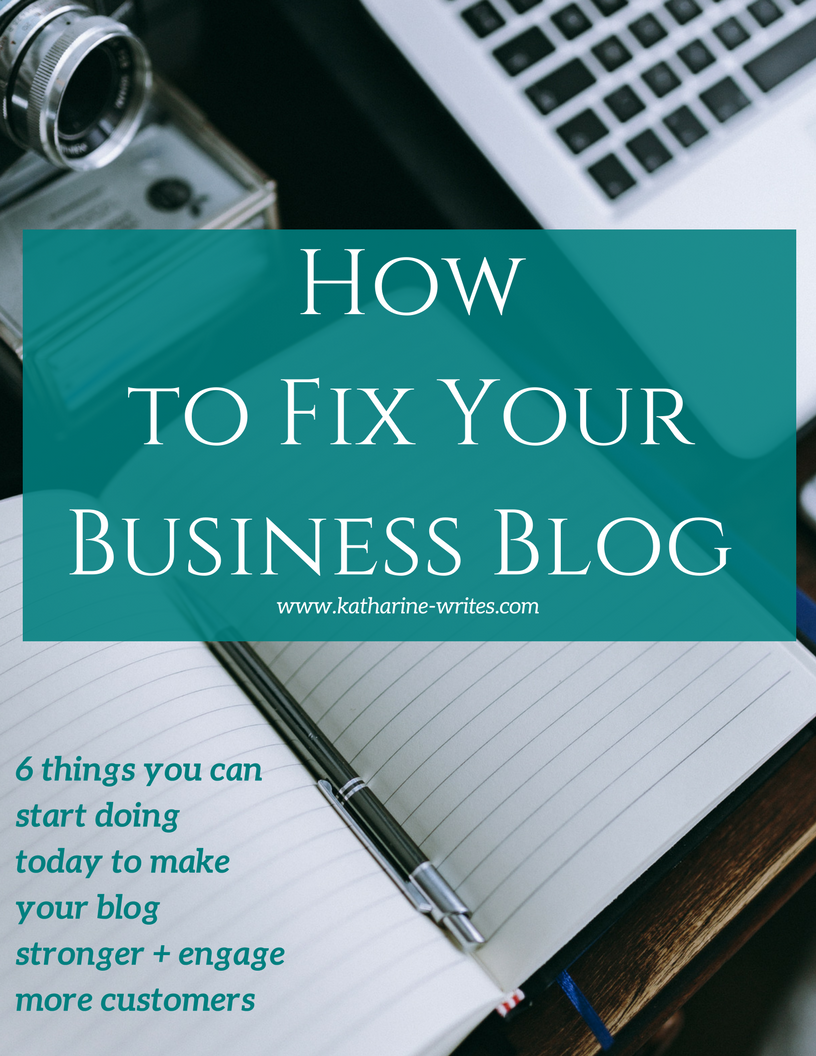Blogging.
Urggh, amiright?
If there’s one thing that working with clients has taught me, it’s that business owners have very mixed feelings about blogging.
On the one hand, they know that it can boost their business, help them connect with customers, and create a steady stream of traffic to their website.
On the other hand, they have no idea how the heck it does that.
Or, they do know, but they feel so far behind — like that’s possible for other business’s blogs, but not their own — that there doesn’t seem any point in trying to catch up.
I get it, believe me. Blogging takes time and energy, and trying to improve a blog that got started on the wrong foot can feel so overwhelming that it’s easier not to begin at all.
But don’t despair, wonderful and entrepreneurial business owners!
You can fix your business blog and create a marketing tool that works for your business. It starts with six not-so-complicated steps.
1. Brainstorm questions
The best use of a business blog is to connect with your customers, to teach them about your business and get them interested in your services.
The best way to help your customers find your business blog is to write so it shows up in search results.
What’s the sweet spot that effectively combines these two points? Questions.
Specifically, the questions your customers are already asking.
The questions they are plugging into Google and hoping to find helpful answers to. The questions they call or email about, wondering what your answers are and how that makes you different from your competitors.
You’ll be doing yourself a favor if you use your blog to answer them!
If you write your blog posts to answer customer questions, you’ll show up in search results, provide necessary information, and solve a problem for your customers right off the bat which will make them more likely to trust you and commit to a purchase.
Brainstorm the questions your customers often ask — and the questions you wish they would ask, because you have great answers! Think about their pain points, the parts of your business process that might not be clear, the information they want to know before they buy.
It probably won’t take you long to come up with at least twenty questions, and once you do, you have the topics for twenty useful, helpful, SEO-friendly blog posts right there.
2. Create an editorial calendar
Do you…
- frequently sit down to write a blog post but spend more time deciding what to write about than actually writing?
- put off blogging because you don’t know what to say?
- miss marketing and promotional opportunities because you don’t remember to tie your posts into what’s going on in your business that week?
Then you are (a) not alone, and (b) in serious need of an editorial calendar.
Setting aside the time to sit down and make an editorial calendar can seem like a huge hassle, but it is soooo worth it.
And the good news is, it doesn’t have to be fancy. It can be a spreadsheet. It can be a Word document. It can be a notebook where you list ideas by date. It can be an actual calendar! The important thing is that it lays out what you will write about and when.
I like to plan out 1-2 months at a time. You may prefer to do more or less, depending on how frequently you blog. And yes, sometimes I change my mind on what to publish when, or I add in a new idea and shuffle things around a bit. That’s okay!
Once you have a plan, you actually have more flexibility.
Trust me, you will be amazed by how good it feels to sit down, open your calendar, and know exactly what you need to write about that day.
 |
Psst! Need a little more guidance on the whole editorial calendar thing? Or maybe you just like everything to be super organized and systematized?
Grab my free template to help you plan every blog post by clicking on the graphic or right here, right now.
|
3. Research keywords
Big disclaimer right up front: keywords are NOT the most important part of your blog post. Your business blog should read like a real person talking and sharing important information, not like a robot spitting out search terms.
I think we’ve all learned that by now, but I just had to say it right from the get-go.
That being said, keywords are important. They help you show up in searches. They make it easier for people to find your site. They connect your blog to the rest of your business.
So it makes sense that you should put a little time into figuring them out, right?
Here’s the thing about keywords: it’s way, way better to lead the search page on a less-common keyword than to show up on page three of a popular one. Because no one is going to look at page three.
So research what your ideal customer is searching for that is unique and specific to your business, then target the hell out of it. Look at your analytics and see what search terms are actually leading visitors to your blog posts, then figure out related terms.
They don’t all have to be 100% specific to your business, but they should be 100% targeted to your ideal customer.
For example, if you sell backpacks, and your ideal customer is a budget-conscious millennial who like to travel, then keywords to target them might be:
- how to pack for a month in a carry-on
- uncommon destinations
- how to pick the right AirBnB
- free things to do when traveling
Set aside time to research your audience and what they search for. Those are your keywords.
Then brainstorm blog post ideas that incorporate those keywords. DON’T stuff your posts with as many keywords as possible. Pick a phrase or two that you want to target, then work it into your post title, headings, and content as naturally as possible.
4. Update old posts
If you’ve been blogging for a while, chances are, you have some old posts that aren’t in great shape.
Maybe the graphics are kind of lousy, or don’t match the style you use now. You might have updated your website design and never gone back to adjust those now-awkward-looking headings. You probably wrote them before you knew anything about SEO.
But odds are, those old posts also have great things going on for them: good advice, solid keyword potential, excellent information about your business and your customers. Don’t let that go to waste! Set aside some time to fix up old blog posts by:
- updating graphics and images
- adding appropriate tags
- working in some keywords and other SEO
- adding a call-to-action or opt-in freebie
- fixing the general appearance of headings, fonts, and other structural elements
Once you’ve done those things? Promote the heck out of them! Pin them, tweet them, share them on Facebook.
Get your new and improved posts out there, because you never know which ones will start attracting attention.
(I’ll be honest — this is one where I need to take my own advice, pronto!)
5. Create an image template
If you use any sort of graphics in your posts — and you really should — your blog will look 1000% more professional and be 1000% easier to put together if you create an image template to use over and over again.
Think about it. Creating a graphic, adjusting the font, filling in the text, making sure everything is sized correctly and uniformly… all that takes a seriously long time.
And when you’ve already spent a chunk of time writing the post, the last thing you want to do it spend more time trying to remember what font you used last week, right?
Do yourself a favor and create a template. Create two. Make them something you can change, adjust, and upload quickly.
I finally started using an image template this year, and then time it took to create graphics for this blog went from about 30 minutes to 3. No joke. It’s worth it.
I love using Canva for this. It’s free as long as you don’t use their designs or photos. Once you’ve created a design, you can download it at any time, then save the file and plug in new photos and text whenever you need.
Psst — Canva is one of my recommended resources for small business owners looking to up their online presence.
Check out the others here. The best part? Most of them are free!
6. Think of the big picture
Here’s the big question to ask yourself if you really want to fix your business blog: what do you want your blog to achieve?
- Do you want it to show off your personality and help your customers learn about the entrepreneur behind the product?
- Do you want to create a go-to resource that people will consult and share with their friends?
- Do you want to drive traffic to your shop?
- Do you want to encourage readers to sign up for your email list so you can promote your products and services there?
You can’t start to make your blog work for your business until you have a clear picture of what you want your blog to achieve. Once you know that, it will guide your content.
- If you want your customers to get to know you, share personal stories and anecdotes. Write in your own conversational voice.
- If you want to create a resource, make sure every post is packed with helpful, actionable tips.
- If you want to drive traffic, use targeted keywords to attract new readers, then link to your shop within your posts.
- If you want email sign-ups, include content upgrades and opt-ins.
Maybe you want all those things. Maybe you want your business blog to achieve something completely different. Whatever works for you and your business!
The point that I hope you’ll take away, though, is that your blog isn’t a stand-alone entity. Blog posts don’t exist in a business vacuum.
Your blog needs to be part of the big picture for your business. Make sure you are keeping that in mind every time you sit down to write.
*****
Need a little more help with your business blog? Check out these posts you might have missed:
11 Way to Make Your Blog Posts More Awesome


Leave a Reply